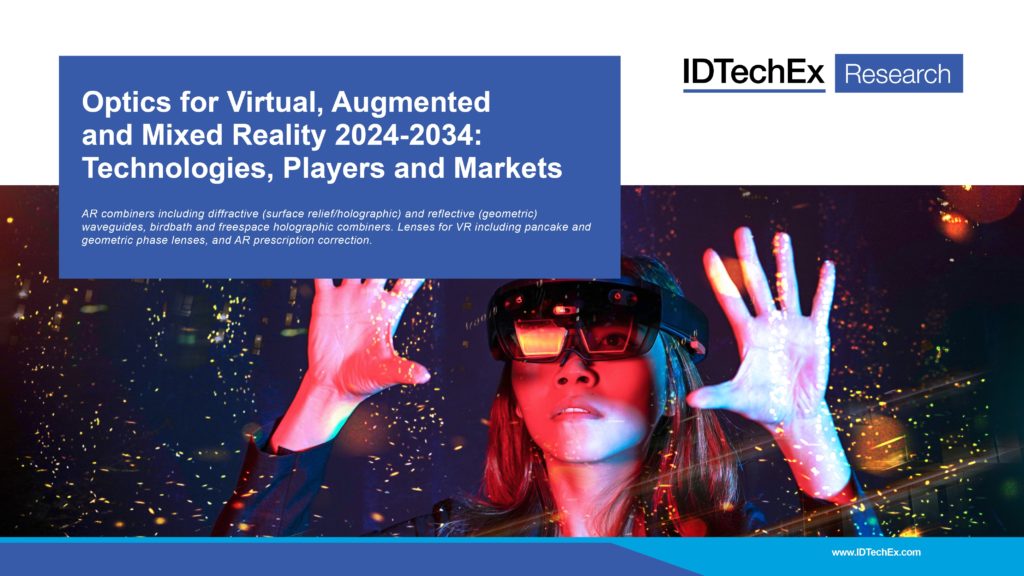For more information, visit https://www.idtechex.com/en/research-report/optics-for-virtual-augmented-and-mixed-reality-2024-2034-technologies-players-and-markets/969.
AR combiners including diffractive (surface relief/holographic) and reflective (geometric) waveguides, birdbath and freespace holographic combiners. Lenses for VR including pancake and geometric phase lenses, and AR prescription correction.
This report characterizes the optics industry, analyzing markets, technologies and players. It provides in-depth coverage of 13 individual optics technologies and forecasts their uptake in spatial computing from 2024 to 2034, alongside 10-year forecasts for the entire VR, AR and MR headset market. It outlines growing opportunity, with the VR, AR and MR optics market forecast to grow to US$5.1bn by 2034.
VR (Virtual Reality) devices replace the real environment with the virtual, whereas AR (Augmented Reality) headsets optically overlay content on top of the real world. Some of these devices can deliver MR (Mixed Reality) experiences, with overlaid virtual content interacting with real objects. Collectively, these concepts are referred to as XR (eXtended Reality) or spatial computing. Apple’s Vision Pro has brought new excitement to this space, gaming-focused VR devices from Meta and others including Pico and Sony have sold in the millions, and AR devices from Vuzix, Microsoft and more have found a valuable place in industry.
However, the specialized optics required by AR headsets have so far proved to be a stumbling block for the industry. In VR headsets, there is rapidly growing usage of unconventional lens types to solve the deficiencies of the Fresnel lens architectures that previously dominated. For AR, an industry of specialized, often fabless, optics firms has sprung up, offering a diverse range of technologies to headset manufacturers that are just as active in this space. Optics are a key enabling technology for spatial computing, driving substantial innovation and growth in the XR optics industry, which is expected to grow at a CAGR of 23% from 2024 to 2034.

Major choices of AR optical combiner

Major choices of lens for VR
The report covers optical combiners and waveguides for AR and lenses for VR, with additional focus placed on prescription correction and encapsulation for waveguides, and the specialized optical materials industry supporting these technologies. Key themes across all technologies, including the maximization of field of view and eyebox, solving the vergence-accommodation conflict, and efforts to improve color rendition are discussed and compared. The activities of headset firms and ecosystem enablers, the demands of end users and other wider market forces are highlighted. The technologies likely to dominate the market are identified with extensive justification, providing a clear sense of future industry development.
Thirteen distinct classes of XR optical technology are analyzed in detail, including surface relief grating diffractive waveguides, holographic waveguides, reflective waveguides, birdbath combiners, Fresnel lenses, pancake lenses and geometric phase lens arrays. This analysis includes:
- In-depth technological and market discussion, tracking innovations, trends and players. Includes market case studies.
- Benchmarking on 12 technological and commercial factors.
- Application suitability analysis for narrow or wide FoV AR or VR headsets depending on technology class.
- 10-year forecasts for adoption, units sold, and revenue for each technology in VR and narrow/wide FoV AR.
Additionally, overall forecasts from 2024-2034 for the VR and AR headset industries that form the market for these display technologies are provided, alongside historical data. Furthermore, high-level demand forecasts for specialized optical materials to serve this market are provided, with key potential opportunities provided. Conclusions on the evolving future of the XR optics market are identified.
This report forms part of IDTechEx’s wider XR portfolio, including “Displays for Virtual, Augmented and Mixed Reality”, “Virtual Reality & Augmented Reality Headsets” and “Micro-LED Displays”. It updates the already-comprehensive 2022 edition of the report with even deeper market insight into this rapidly changing industry, including a substantial improvement to benchmarking methodology, analysis of the rapid rise of pancake lenses in VR, and expanded discussion of waveguide manufacturing processes and prescription correction in AR.
IDTechEx’s methodology involved extensive primary and secondary research with a key focus on interviewing executives and engineers within the display and wider XR ecosystems, in addition to attendance of major conferences including CES, SID Display Week, Laval Virtual and AWE Europe. It provides over 30 company profiles as well as further case studies of important developments in the XR optics world.


